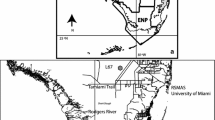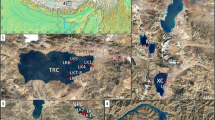Abstract
Oxygen and carbon isotope compositions of fossil bird eggshell calcite (δ18Ocalc and δ13Ccalc) are regularly used to reconstruct paleoenvironmental conditions. However, the interpretation of δ18Ocalc values of fossil eggshells has been limited to qualitative variations in local climatic conditions as oxygen isotope fractionations between calcite, body fluids, and drinking water have not been determined yet. For this purpose, eggshell, albumen water, and drinking water of extant birds have been analyzed for their oxygen and carbon isotope compositions. Relative enrichments in 18O relative to 16O between body fluids and drinking water of +1.6 ± 0.9 ‰ for semi-aquatic birds and of +4.4 ± 1.9 ‰ for terrestrial birds are observed. Surprisingly, no significant dependence to body temperature on the oxygen isotope fractionation between eggshell calcite and body fluids is observed, suggesting that bird eggshells precipitate out of equilibrium. Two empirical equations relating the δ18Ocalc value of eggshell calcite to the δ18Ow value of ingested water have been established for terrestrial and semi-aquatic birds. These equations have been applied to fossil eggshells from Lanzarote in order to infer the ecologies of the Pleistocene marine bird Puffinus sp. and of the enigmatic giant birds from the Pliocene. Both δ13Ccalc and δ18Ocalc values of Puffinus eggshells point to a semi-aquatic marine bird ingesting mostly seawater, whereas low δ13Ccalc and high δ18Ocalc values of eggshells from the Pliocene giant bird suggest a terrestrial lifestyle. This set of equations can help to quantitatively estimate the origin of waters ingested by extinct birds as well as to infer either local environmental or climatic conditions.









Similar content being viewed by others
References
Amiot R, Buffetaut E, Lécuyer C, et al. (2010) Oxygen isotope evidence for semi-aquatic habits among spinosaurid theropods. Geology 38:139–142
Amiot R, Wang X, Zhou Z, et al. (2015) Environment and ecology of East Asian dinosaurs during the Early Cretaceous inferred from stable oxygen and carbon isotopes in apatite. J Asian Earth Sci 98:358–370. doi:10.1016/j.jseaes.2014.11.032
Anderson TF, Arthur MA (1983) Stable isotopes of oxygen and carbon and their application to sedimentologic and paleoenvironmental problems. In: Stable isotopes in sedimentary geology. SEPM (Society for Sedimentary Geology), pp 1–151
Angst D, Amiot R, Buffetaut E, et al. (2015) Diet and climatic context of giant birds inferred from δ13Cc and δ18Oc values of Late Palaeocene and Early Eocene eggshells from southern France. Palaeogeogr Palaeoclimatol Palaeoecol 435:210–221. doi:10.1016/j.palaeo.2015.06.011
Angst D, Lécuyer C, Amiot R, et al. (2014) Isotopic and anatomical evidence of an herbivorous diet in the Early Tertiary giant bird Gastornis. Implications for the structure of Paleocene terrestrial ecosystems. Naturwissenschaften 101:313–322. doi:10.1007/s00114-014-1158-2
Bicudo JEP, Buttemer WA, Chappell MA, et al. (2010) Ecological and environmental physiology of birds. Oxford University Press, Oxford 317pp
Bowen GJ (2009) The online isotopes in precipitation calculator, version 2.2. Available from:<http://www.waterisotopes.org.
Bowen GJ, Revenaugh J (2003) Interpolating the isotopic composition of modern meteoric precipitation. Water Resour Res 39:1299. doi:10.1029/2003WR002086
Bowen GJ, Wilkinson B (2002) Spatial distribution of δ18O in meteoric precipitation. Geology 30:315–318
Bowen GJ, Wassenaar LI, Hobson KA (2005) Global application of stable hydrogen and oxygen isotopes to wildlife forensics. Oecologia 143:337–348. doi:10.1007/s00442-004-1813-y
Cerling TE, Harris JM, Hart JA, et al. (2008) Stable isotope ecology of the common hippopotamus. J Zool 276:204–212
Clarke A, O’Connor MI (2014) Diet and body temperature in mammals and birds. Glob Ecol Biogeogr 23:1000–1008. doi:10.1111/geb.12185
Clementz MT, Goswami A, Gingerich PD, Koch PL (2006) Isotopic records from early whales and sea cows: contrasting patterns of ecological transition. J Vertebr Paleontol 26:355–370. doi:10.1671/0272-4634(2006)26[355:IRFEWA]2.0.CO;2
Clementz MT, Holroyd PA, Koch PL (2008) Identifying aquatic habits of herbivorous mammals through stable isotope analysis. PALAIOS 23:574–585
Coplen TB, Kendall C, Hopple J (1983) Comparison of stable isotope reference samples. Nature 302:236–238
Dansgaard W (1964) Stable isotopes in precipitation. Tellus A 16:438–468
Dawson WR (1982) Evaporative losses of water by birds. Comp Biochem Physiol A Physiol 71:495–509
Erben HK, Hoefs J, Wedepohl KH (1979) Paleobiological and isotopic studies of eggshells from a declining dinosaur species. Paleobiology 5:380–414
Fertuck HC, Newstead JD (1970) Fine structural observations on magnum mucosa in quail and hen oviducts. Z Zellforsch Mikrosk Anat 103:447–459
Feuerbacher I, Prinzinger R (1981) The effects of the male sex-hormone testosterone on body temperature and energy metabolism in male Japanese quail (Coturnix coturnix japonica). Comp Biochem Physiol A Physiol 70:247–250
Folinsbee RE, Fritz P, Krouse HR, Robblee AR (1970) Carbon-13 and oxygen-18 in dinosaur, crocodile, and bird eggshells indicate environmental conditions. Science 168:1353–1355
Fricke HC, O’Neil JR (1999) The correlation between 18O/16O ratios of meteoric water and surface temperature: its use in investigating terrestrial climate change over geologic time. Earth Planet Sci Lett 170:181–196
Garcia-Talavera F (1990) Aves gigantes en el Mioceno de Famara (Lanzarote). Rev Acad Canar Cienc Folia Canar Acad Sci 2:71–79
Gardner JL, Peters A, Kearney MR, et al. (2011) Declining body size: a third universal response to warming? Trends Ecol Evol 26:285–291. doi:10.1016/j.tree.2011.03.005
Guillette LJ Jr, Cree A, Rooney AA (1995) Biology of stress: interactions with reproduction, immunology and intermediary metabolism. In: Warwick C, Frye FL, Murphy JB (eds) Health and welfare of captive reptiles. Springer, Dordrecht, pp. 32–81
Hadley NF (1980) Surface waxes and integumentary permeability: lipids deposited on or associated with the surface of terrestrial plants and animals help protect them from a lethal rate of desiccation. Am Sci 68:546–553
Hammer Ø, Harper DAT, Ryan PD (2001) PAST: paleontological statistics software package for education and data analysis. Palaeontol Electron 4:9pp
Hoffman TC, Walsberg GE, DeNardo DF (2007) Cloacal evaporation: an important and previously undescribed mechanism for avian thermoregulation. J Exp Biol 210:741–749
IAEA/WMO (2015) Global network of isotopes in precipitation. The GNIP Database. Accessible at: http://www-naweb.iaea.org/napc/ih/index.html.
Imai T, Azuma Y (2015) The oldest known avian eggshell, Plagioolithus fukuiensis, from the Lower Cretaceous (upper Barremian) Kitadani Formation, Fukui, Japan. Hist Biol 27:1090–1097. doi:10.1080/08912963.2014.934232
Johnson BJ, Fogel ML, Miller GH (1998) Stable isotopes in modern ostrich eggshell: a calibration for paleoenvironmental applications in semi-arid regions of southern Africa. Geochim Cosmochim Acta 62:2451–2461
Kim S-T, O’Neil JR (1997) Equilibrium and nonequilibrium oxygen isotope effects in synthetic carbonates. Geochim Cosmochim Acta 61:3461–3475
Koch PL (2007) Isotopic study of the biology of modern and fossil vertebrates. In: Michener R, Lajtha K (eds) Stable isotopes in ecology and environmental science, Second edn. Blackwell Publishing, Malden, pp. 99–154
Kohn MJ (1996) Predicting animal δ18O: accounting for diet and physiological adaptation. Geochim Cosmochim Acta 60:4811–4829
Lasiewski RC, Dawson WR (1967) A re-examination of the relation between standard metabolic rate and body weight in birds. Condor 69:13–23. doi:10.2307/1366368
Luz B, Kolodny Y (1985) Oxygen isotope variations in phosphate of biogenic apatites, IV. Mammal teeth and bones. Earth Planet Sci Lett 75:29–36. doi:10.1016/0012-821X(85)90047-0
Mackenzie GJ, Schaffner FC, Swart PK (2015) The stable isotopic composition of carbonate (C & O) and the organic matrix (C & N) in waterbird eggshells from South Florida: insights into feeding ecology, timing of egg formation, and geographic range. Hydrobiologia 743:89–108. doi:10.1007/s10750-014-2015-1
Maurer G, Portugal SJ, Boomer I, Cassey P (2011) Avian embryonic development does not change the stable isotope composition of the calcite eggshell. Reprod Fertil Dev 23:339–345. doi:10.1071/RD10138 1031-3613/11/020339
McMinn M, Jaume D (1990) Puffinus olsoni n. sp.: nova espècie de baldritja recentment extingida provinent de depòsits espeleològics de Fuerteventura i Lanzarote (Illes Canàries, Atlàntic Oriental). Endins Publicació Espeleol 63–72.
McNab BK (1966) An analysis of the body temperatures of birds. Condor 68:47–55. doi:10.2307/1365174
Mikhailov KE (1991) Classification of fossil eggshells of amniotic vertebrates. Acta Palaeontol Pol 36:193–238
Mikhailov KE (1997) Fossil and recent eggshell in amniotic vertebrates: fine structure, comparative morphology and classification. Spec Pap Palaeontol 56:1–80
Nys Y, Gautron J, Garcia-Ruiz JM, Hincke MT (2004) Avian eggshell mineralization: biochemical and functional characterization of matrix proteins. Comptes Rendus Palevol 3:549–562. doi:10.1016/j.crpv.2004.08.002
Pokrovskaya OB, Litvin KE, Pokrovsky BG (2011) The isotope composition of carbon and oxygen in eggshell of barnacle goose Branta leucopsis. In: Doklady Biological Sciences. Springer, pp 124–127.
Prinzinger R, Pressmar A, Schleucher E (1991) Body temperature in birds. Comp Biochem Physiol A Physiol 99:499–506
Rothe P (1964) Fossile Strausseneier auf Lanzarote. Nat Mus 94:175–187
Rozanski K, Araguás-Araguás L, Gonfiantini R (1993) Isotopic patterns in modern global precipitation. Clim Change Cont Isot Rec 78:1–36. doi:10.1029/GM078p0001
Sanchez Marco A (2010) New data and an overview of the past avifaunas from the Canary Islands. Ardeola 57:13–40
Sarkar A, Bhattacharya SK, Mohabey DM (1991) Stable-isotope analyses of dinosaur eggshells: paleoenvironmental implications. Geology 19:1068–1071. doi:10.1130/0091-7613(1991)019<1068:SIAODE>2.3.CO;2
Sauer EF, Rothe P (1972) Ratite eggshells from Lanzarote, Canary Islands. Science 176:43–45
Schaffner FC, Swart PK (1991) Influence of diet and environmental water on the carbon and oxygen isotopic signatures of seabird eggshell carbonate. Bull Mar Sci 48:23–38
Sokal RR, Rohlf FJ (2009) Introduction to biostatistics, 2nd edn. Dover Publications Incorp, Mineola, New York
Swart PK, Price RM, Greer L (2001) The relationship between stable isotopic variations (O, H, and C) and salinity in waters and corals from environments in South Florida: implications for reading the paleoenvironmental record. Bull Am Paleontol 17–30.
Turekian KK, Steele JH, Thorpe SA (2009) Climate & oceans: a derivative of the encyclopedia of ocean sciences, 1st edn. Academic Press, Amsterdam
Tütken T (2014) Isotope compositions (C, O, Sr, Nd) of vertebrate fossils from the Middle Eocene oil shale of Messel, Germany: implications for their taphonomy and palaeoenvironment. Palaeogeogr Palaeoclimatol Palaeoecol 416:92–109
Tütken T, Vennemann TW, Janz H, Heizmann EPJ (2006) Palaeoenvironment and palaeoclimate of the Middle Miocene lake in the Steinheim basin, SW Germany: a reconstruction from C, O, and Sr isotopes of fossil remains. Palaeogeogr Palaeoclimatol Palaeoecol 241:457–491. doi:10.1016/j.palaeo.2006.04.007
Tyler C (1969) A study of the egg shells of the Gaviiformes, Procellariiformes, Podicipitiformes and Pelecaniformes. J Zool 158:395–412
Von Schirnding Y, Van Der Merwe NJ, Vogel JC (1982) Influence of diet and age on carbon isotope ratios in ostrich eggshell. Archaeometry 24:3–20
Walker CA, Wragg GM, Harrison CJ (1990) A new shearwater from the Pleistocene of the Canary Islands and its bearing on the evolution of certain Puffinus shearwaters. Hist Biol 3:203–224
Acknowledgments
The authors thank G. Douay (PARC DE LA Tête d’Or, Lyon, France), S. Sweetman (University of Porthmouth), F. Lafuma, M. Arnould, J. Claude (ISEM), F. Thibon, L. Lambs (ECOLAB), and all the anonymous individual farmers for assistance in egg and water collection or analysis, as well as T. Tütken (Universität Mainz) and two anonymous reviewers for their constructive comments that greatly helped to improve the manuscript. This study was supported by the Institut Universitaire de France (C.L.). The work by A. Sánchez Marco was supported by the grants CGL2011-28681, the Spanish Ministry of Science and Innovation, and 2014 SGR 416 and 437 K117, Generalitat de Catalunya, and the CNRS INSU program INTERRVIE.
Author information
Authors and Affiliations
Corresponding author
Additional information
Communicated by: Robert R. Reisz
Rights and permissions
About this article
Cite this article
Lazzerini, N., Lécuyer, C., Amiot, R. et al. Oxygen isotope fractionation between bird eggshell calcite and body water: application to fossil eggs from Lanzarote (Canary Islands). Sci Nat 103, 81 (2016). https://doi.org/10.1007/s00114-016-1404-x
Received:
Revised:
Accepted:
Published:
DOI: https://doi.org/10.1007/s00114-016-1404-x




